
Astragalus alpinus is a species of flowering plant in the legume family known by the common name alpine milkvetch. It has a circumpolar distribution, occurring throughout the upper latitudes of the Northern Hemisphere.

Astragalus newberryi, is a flowering plant in the family Fabaceae, native to the western United States from Idaho to New Mexico and California. A variety is found in the Death Valley area and the eastern Mojave Desert in California and Nevada. It grows in rocky and gravelly areas between 1,300–2,350 metres (4,270–7,710 ft) elevation.

Astragalus canadensis is a common and widespread member of the milkvetch genus in the legume family, known commonly as Canadian milkvetch. The plant is found throughout Canada and the United States in many habitats including wetlands, woodlands, and prairies.

Astragalus bisulcatus, commonly called two-grooved milkvetch or silver-leafed milkvetch, is a leafy perennial with pea-like flowers. It is native to central and western North America, and typically grows on selenium-rich soils. It accumulates selenium within its tissues, and when livestock consume it, the selenium can be toxic.
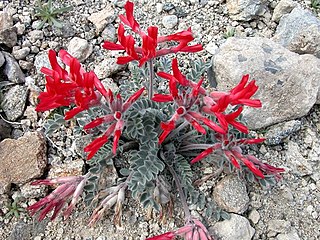
Astragalus coccineus is a species of milkvetch known by the common name scarlet locoweed or scarlet milkvetch. It is native to the deserts, scrub, and chaparral of the Southwestern United States in Arizona, California, and Nevada, and in northwestern Mexico.
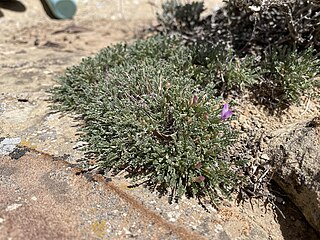
Astragalus humillimus is a rare species of milkvetch known by the common name Mancos milkvetch. It is native to a small section of the Four Corners region of the United States, where it can be found in Montezuma County, Colorado, and San Juan County, New Mexico. There are about nine small, localized populations on sandstone rimrock ledges on the mesas. The plant occurs in a region that is being developed for oil and gas exploration, and altered by associated activities such as road construction and pipeline installation. It is a federally listed endangered species.
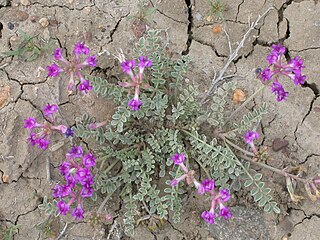
Astragalus missouriensis is a species of flowering plant in the legume family known by the common name Missouri milkvetch. It is native to central North America, where it is common and widespread.

Astragalus microcymbus is a species of flowering plant in the legume family known by the common name skiff milkvetch. It is endemic to Colorado in the United States, where it is known from Gunnison County and the edge of Saguache County. It was discovered in 1945 by Rupert Barneby, a British botanist. Currently, skiff milkvetch is experiencing population declines and is listed as a Tier 1 species in the Rare Plant Addendum to the Colorado State Wildlife Action Plan.

Astragalus schmolliae is a species of flowering plant in the legume family known by the common name Schmoll's milkvetch. It is endemic to Colorado in the United States, where it is limited to Montezuma County. It grows only on Chapin Mesa in Mesa Verde National Park.
Astragalus leptaleus is a species of flowering plant in the legume family known by the common name park milkvetch. It is native to the Rocky Mountains of the United States, where it occurs in Idaho, Montana, Wyoming, and Colorado.

Astragalus molybdenus is a species of flowering plant in the legume family known by the common names Leadville milkvetch and molybdenum milkvetch. It is endemic to Colorado in the United States. If the separate species Astragalus shultziorum and Astragalus lackschewitzii are included in A. molybdenum the range expands into Wyoming and Montana.

Astragalus proximus is a species of flowering plant in the legume family known by the common name Aztec milkvetch. It is native to southern Colorado and northern New Mexico in the United States.
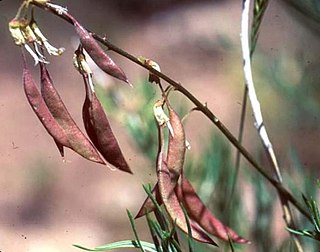
Astragalus ripleyi is a species of flowering plant in the legume family known by the common name Ripley's milkvetch. It is native to southern Colorado and northern New Mexico in the United States.
Astragalus wetherillii is a species of flowering plant in the legume family known by the common name Wetherill's milkvetch. It is native to Colorado and Utah in the United States.

Astragalus amphioxys, common name crescent milkvetch, is a plant found in the American southwest, including the whole of Utah, the southeast part of Nevada, the north part of Arizona, the western part of Colorado, the northwestern part of New Mexico, and one county in Texas. It was first described by Asa Gray in 1878.
Astragalus flavus is a perennial plant in the legume family (Fabaceae) found in the Colorado Plateau and Canyonlands region of the southwestern United States.

Astragalus crassicarpus, known as ground plum or buffalo plum, is a perennial species of flowering plant in the legume family, Fabaceae, native to North America. It was described in 1813. The fruit is edible and was used by Native Americans as food and horse medicine. It is a host of afranius duskywing larvae. It is also known as groundplum milkvetch and pomme de prairie.

Astragalus plattensis, the Platte River milkvetch, is a species of flowering plant in the legume family, Fabaceae, native to North America. It was named in 1838. Its range includes the Great Plains of the United States, from southern Montana and North Dakota south to central Texas.

Astragalus racemosus, the cream milkvetch, is a species of flowering plant in the family Fabaceae. It is native to central North America. A selenium hyperaccumulator, it is considered capable of poisoning livestock as one of the locoweeds.
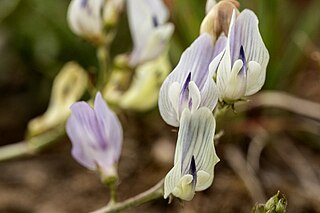
Astragalus miser, the timber milkvetch, is a species of flowering plant in the family Fabaceae. A perennial, it is native to western North America, except California. One of the locoweeds toxic to livestock, it contains miserotoxin.


















